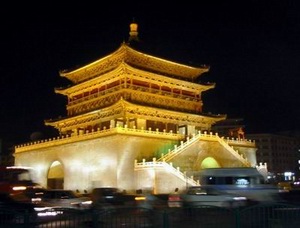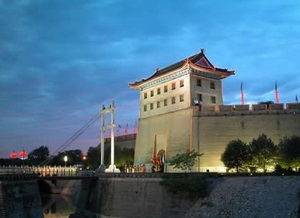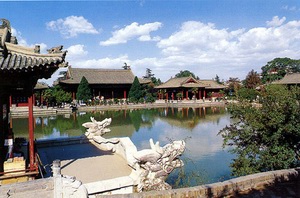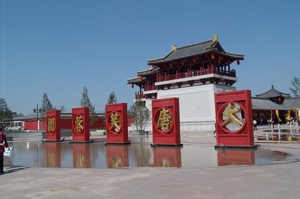|
Welcome to Xi'an
A World-famous Tourist City and A Treasure House of Cultural Relics
Xi'an, the eternal city, records the great changes of the Chinese nation just like a living history book. Called Chang'an in ancient times, Xi'an is one of the birthplaces of the ancient civilization in the Yellow River Basin area of the country. During Xi'an's 3,100 year development, 13 dynasties such as Zhou, Qin, Han and Tang placed their capitals here. So far, Xi'an enjoys equal fame with Athens, Cairo, and Rome as one of the four major ancient civilization capitals.
Xi'an is the capital of Shaanxi province, located in the southern part of the GuanZhong Plain. With the Qinling Mountains to the north and the Weihe River to the south, it is in a favorable geographical location surrounded by water and hills. It has a semi-moist monsoon climate and there is a clear distinction between the four seasons. Except the colder winter, any season is relatively suitable for traveling.
The cultural and historical significance of the area, as well as the abundant relics and sites, help Xi'an enjoy the laudatory title of "Natural History Museum". The Museum of Terra Cotta Warriors and Horses is praised as "the eighth major miracle of the world", Mausoleum of Emperor Qin Shi Huang is listed on the World Heritage List, and the City Wall of the Ming Dynasty is the largest and most intact Ming Dynasty castle in the world. In the city, there is the 3000 year old Banpo Village Remains from the Neolithic Age, and the Forest of Stone Steles that holds 3,000 stone steles of different periods from the Han Dynasty to the Qing Dynasty. Around Xi'an, the Famen Temple enjoys the reputation of being the "forefather of pagodas and temples in Central Shaanxi," because it holds the finger bones of Sakyamuni--the founder of Buddhism. The natural landscape around Xi'an is also marvelous. Mt. Huashan, as one of the five best-known mountains in China, is famous for its breath-taking cliffs and its unique characteristics.
As tourist development grows in Xi'an, the hotel industry flourishes more and more. It is very easy to find a hotel in Xi'an, ranging from 5 star hotels to youth hostels. Of course, it will be any traveler's first choice to stay in the city center due to the superior geographical location and the convenient transportation.
Praised as "the capital of table delicacies", Xi'an has been rich in the delicious Shaanxi snack, delicate Guangdong Cuisine, various kinds of fashionable foreign delicacies, and popular Sichuan Cuisine such as the hot pot. Among all the delicacies, the most famous and popular one is the Muslim Snack Street.
Xi'an is the most important city in northwest China, and so there are a lot of shopping outlets for locals and tourists alike. There are many big shopping centers, department stores and supermarkets in and around Xi'an city - the biggest and most comprehensive being Kai Yuan Shopping Mall and Century Ginwa Shopping Mall.
The night life in Xi'an has a unique glamour. Traditional ways include enjoying the night scenery around the Bell Tower, taking part in a Tang Dynasty Dinner Show, strolling on the ancient Big Wild Goose Pagoda Square and watching the music fountain performance. More modern and fashionable ways include singing in the KTV, hanging out in a bar, or dancing in a Disco. All in all, any experience in this ancient city will bring you fun and possibly a little surprise!
|
|
|
The well-known Terra-cotta Museum is located east of Emperor Qin's Mausoleum, which covers a total area of 20 hectares. The museum is decorated with verdant trees, blooming flowers and carpets of green grass. The scenery in the museum looks quite elegant and delightful. Three main buildings of the museum, which were named Pit 1,Pit 2, Pit 3, were constructed on their original sites in different periods of time. Emperor Qin's Terra-cotta Museum is not only a treasure house where the tourists can learn history, culture and human civilization, but also a main scenic spot of Xi'an city. Today "the eighth Wonder of the world" has almost become synonym of the Terra-cotta Warriors and Horses In 1987, the Emperor Qin's Mausoleum was put on the list of the UNESCO as a world-class cultural heritage site.
|
Terra-cotta Museum
|
|
|
|
|
|
|
 |
Bell Tower (Zhong Lou)
The Bell Tower, is a stately traditional building, that marks the geographical center of the ancient capital. From this important landmark extend East, South, West and North Streets, connecting the Tower to the East, South, West and North Gates of the City Wall of the Ming Dynasty.The wooden tower, which is the largest and best-preserved of its kind in China, is 36 meters (118 feet) high. It stands on a brick base 35.5 meters (116.4 feet) long and 8.6 meters (28.2 feet) high on each side. During the Ming Dynasty, Xi'an was an important military town in Northwest China, a fact that is reflected in the size and historic significance of its tower.
|
|
| |
When Zhu Yuanzhang, the first Emperor of the Ming dynasty (1368-1644), captured Huizhou, a hermit named Zhu Sheng admonished him that he should "built high walls, store abundant food supplies and take time to be an Emperor," so that he could fortify the city and unify the other states. After the establishment of the Ming dynasty, Zhu Yuanzhang followed his advice and began to enlarge the wall built initially during the old Tang dynasty (618 -907), creating the modern Xi'an City Wall. It's the most complete city wall that has survived in China, as well being one of the largest ancient military defensive systems in the world. After the extension, the wall now stands 12 meters (40 feet) tall, 12-14 meters (40-46 feet) wide at the top and 15-18 meters (50-60 feet) thick at the bottom. It covers 13.7 kilometers (8.5 miles) in length with a deep moat surrounding it.
|
City Wall

|
|
|
Big Wild Goose Pagoda
As the symbol of the old-line Xi'an, Big Wild Goose Pagoda is a well-preserved ancient building and a holy place for Buddhists. It is located in the southern suburb of Xi'an City, about 4 kilometers (2.49 miles) from the downtown of the city. It was built in 652 during the Tang Dynasty and originally had five stories, although the structure was rebuilt in 704 during the reign of Empress Wu Zetian and its exterior brick facade renovated during the Ming Dynasty. One of the pagoda's many functions was to hold sutras and figurines of the Buddha that were brought to China from India by the Buddhist translator and traveller Xuanzang.Standing in the Da Ci'en Temple complex, it attracts numerous visitors for its fame in the Buddhist religion, its simple but appealing style of construction, and its new square in front of the temple. It is rated as a National Key Cultural Relic Preserve as well as an AAAA Tourist Attraction.This attraction can be divided into three parts: the Big Wild Goose Pagoda, the Da Ci'en Temple, and the North Square of Big Wild Goose Pagoda.
|
|
Mt. Huashan
As one of the five best-known mountains in China, Mt. Huashan is located in the Shaanxi Province, about 100 kilometres east of the city of Xi'an, near the city Huayin in China, with an elevation of 2200 meters above sea level. In ancient times, Mt. Huashan was called Mt. Taihuashan. Seen from afar, the five peaks looks like five petals of a flower. Hence its name, Mt. Huashan (= five flowers). Today, it is listed as one of the renowned national scenic spots. |
|
| |
|
|
Huaqing Hot Springs
 |
Situated at the northern foot of Mt. Lishan in Lintong County, 30 kilometers (18.6 miles) from Xi'an City, Huaqing Hot Spring is famed for both its dainty spring scenery and the romantic love story of Emperor Xuanzong (685-762) and his concubine Yang Guifei in the Tang Dynasty (618-907). Its long history and location among the wonderful landscapes of Xi'an should entice any visitor to visit and bathe in this hot spring.It is said that King You built a palace here during the Western Zhou Dynasty (11th century BC-711 BC). Additions were subsequently made by the First Emperor Qing (259 BC-210BC) and Emperor Wu during the Western Han Dynasty (206 BC-24).The palace thus has a history of 3,000 years and the hotspring a history of 6,000 years!Ranked among the Hundred Famous Garden in China, it has the status as a National Cultural Relic Protection Unit and a National Key Scenic Area.
|
|
|
Near the Big Wild Goose Pagoda , Tang Paradise is located in the Qujiang Resort, southeast of the Xi'an City, Shaanxi Province. It is a newly opened tourist attraction in April, 2005. Tang Paradise covers a total area of 1000 mu (about 165 acres) and of which 300 mu (about 49 acres) is water. This tourist attraction not only claims to be the biggest cultural theme park in the northwest region of China but also the first royal-garden-like park to give a full display of the Tang Dynasty's (618-907) culture.Altogether, twelve scenic regions are distributed throughout Tang Paradise to provide visitors with the enjoyment of twelve cultural themes and a perfect exhibition of the grandness, prosperity and brilliance of the culture of the Tang Dynasty.
|
Tang Paradise
 |
|
|
|



